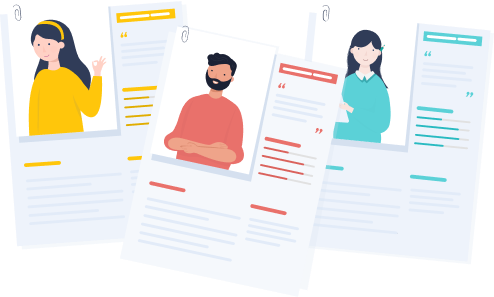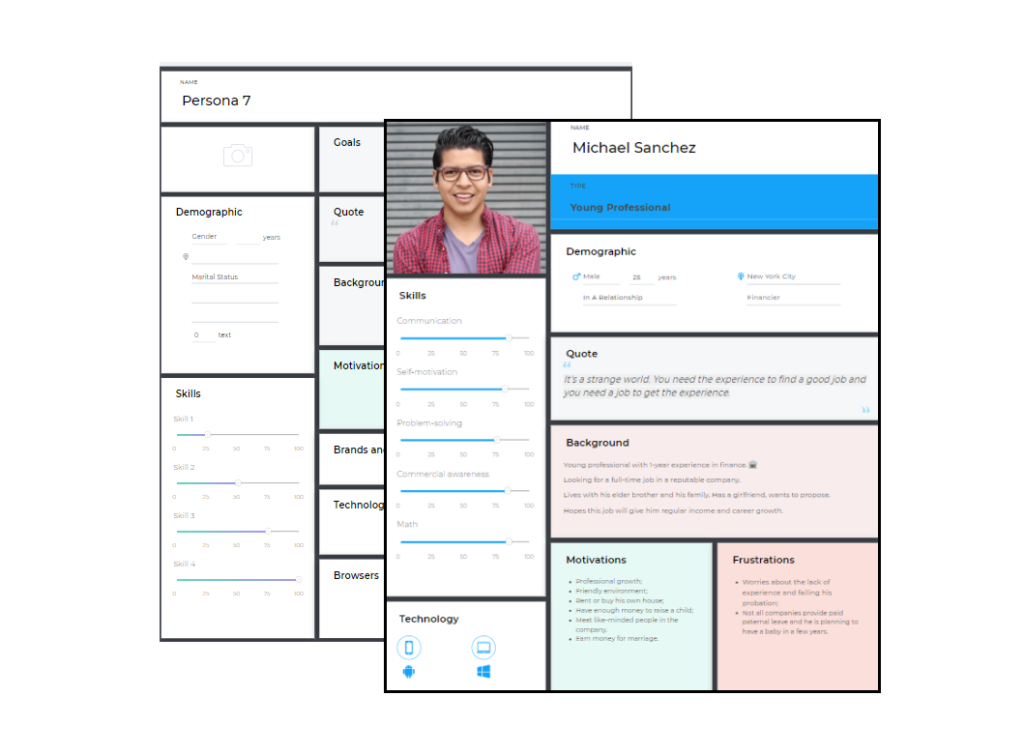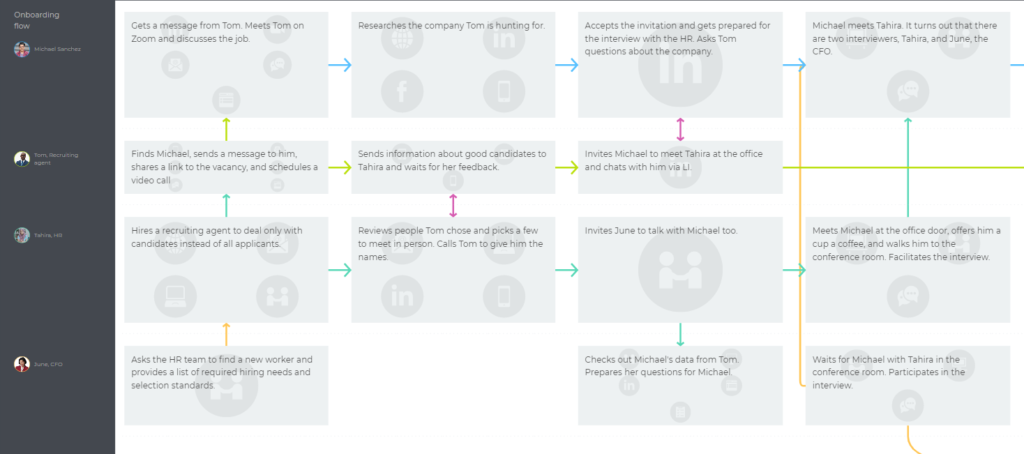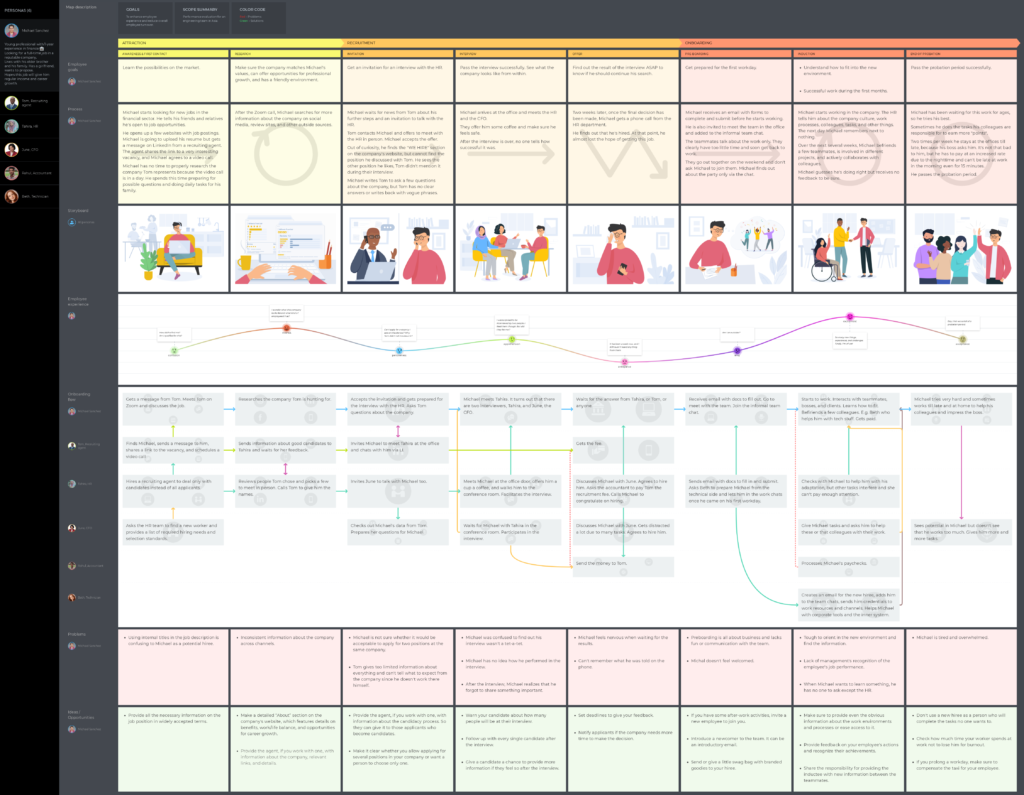Human resources are the core of any organization, its capabilities, and the driving force. No wonder recruiting is one of the essential elements of a business. At the same time, finding, attracting, hiring, and onboarding people takes a lot of resources. And often, having hired somebody perfect for their position, you return to the start while many more vacancies are on the way to your HR task list.
To make the recruiting process as efficient as possible, you can find a magic lamp, seek external help from HR agencies (alas, not the option when this agency is you), or study your HR department’s internal kitchen and the experience of candidates and new hirees. Then valuable insights at hand with an action plan will not take long.
Contents
Why consider journey mapping in recruitment?

The recruitment process is bursting with challenges every HR specialist dreams of zooming smoothly between. How to attract the right people without spending much time reviewing applications from those who clearly are not a good fit? What engagement techniques are better to retain the perfect candidates so that no other companies or agencies entice them away from you? How to optimize the recruitment flow to timely close human resource gaps in the organization?
Well, a candidate journey map (or candidate-specific stages of an employee journey map) can become a reference book for the HR department and even kind of a go-to source for everyone involved in the hiring process.
But first, what is journey mapping in recruiting? It’s a method that comprises three major steps: gathering information about candidates, visualizing their experience by creating a map of their “journey”, and finding problems that can be fixed coupled with ideas on how to do so.
All in all, you end up with a visual representation of a candidate's journey composed of interactions with your company and spiced out with this candidate’s goals, motivations, frustrations, actions, expectations, and more.
How long does such a journey last? A candidate’s path starts when a person learns about your company or starts looking for a job and ideally ends with retirement in old age. Okay, maybe in a few years of effective and fruitful work. But sometimes that journey cuts short long before the expected happy ending. A candidate’s journey is a part of an employee’s journey, but its successful frontier is a passed probation period.
When reviewing each stage of the candidate's journey, you will better understand their experience and find points of its improvement, which will certainly allow you to quicker and better form harmonious teams of highly motivated and engaged employees.
Things to remember about journey mapping in recruiting

Your company may already practice journey mapping, trying to improve customer or user experience. Or the HR department has built an employee performance journey to increase staff retention. Or you are going to approach an employee journey for the first time in your life. Anyway, reminding key things about journey mapping in recruiting will always come in handy.
When diving into a candidate experience, you end in the loop where you and a candidate both sell and buy something: skills, time, money, etc. But during the mapping process, you need to focus on the candidate's experience only and look at everything from your candidate persona’s angle. This means not replacing their goals with yours or considering channels that fit you throughout recruitment instead of identifying those that work best for the candidates.
Personas and journey maps will only be true to life and actionable with proper research. With customers, clients, or users, there are many ways to collect information, especially about the issues and pitfalls in their experience. But with employees, it may be a little bit tricky. Employees are another universe to discover, as they are not that fast to share negative thoughts, fearing реу consequences.
Pro tip: Some people who went through a not-so-perfect candidate journey leave you before hiring, never getting to the onboarding process. Be proactive and ask even those whom you are not going to hire what they think about the recruitment nuances in your company.
Benefits of having such a journey map
If you are still on the fence about using journey mapping in recruiting, here are six (of many more) perks of having a candidate journey map:

- You don't fantasize about your ideal or real candidates. You know their background, their challenges and pain points, and how best to interact with them. That helps to close the breach between illusion and reality.
- You can go beyond the boundaries of the journey in its usual sense and improve not only direct interactions with your personas but also the company's image as an employer outside these interactions.
- 81% of candidates consider regular feedback and status updates from the employer or recruiter throughout the candidate journey a good experience enhancer. With a journey map at hand, you will know for sure at what stages your personas expect you to follow up and through what channels.
- Workers are fish in the vast sea, and to catch yours, you need to know where to set the nets. Understanding what job-related platforms and channels your personas use will help to do this.
- More people will pass the probationary period and be happy to work further. That is, the positive effect on the recruiting journey will echo through all stages of the employee journey and improve the entire employee experience.
- The company has a single source of truth about the people it wants to hire and is recruiting. Thus, your colleagues will understand their role in the candidate journey and the steps they can take to take it to the next level.
Journey mapping in recruitment: how to do it right
Like any initiative, journey mapping in recruitment can’t be launched abruptly. First, you need to gather a team. Mapping is a collaborative methodology. So ideally, this team should include not only people from the HR department but also researchers, colleagues from other departments, and top managers. Together, you will decide on the scope of the soon-to-be-mapped journey and specify the purpose of this project. You also have to understand how frequently you are going to meet, who will be responsible for what, etc. Then you will collect a sufficient amount of information and proceed to building personas.
Building a persona

Personas in the recruitment journey are called candidates. Candidate persona profiles help HRs to navigate the seemingly endless space of people who are searching for a job or might switch jobs or are just going to graduate and become a part of a labor market. Such profiles let you focus only on those who fit most of its content, use the right channels to reach out, and tweak your messages to the relevant pains and motivations of a potential employee.
To build your candidate persona(s), you have to collect valuable data to put into their profiles. It can be information from past job interviews or feedback shared by the team and top managers. If you’re new to personas, check out our Persona creation guide with expert tips and template library with ready-to-go persona profiles.

Pro tip: Sometimes it’s important to have not only candidate persona profiles. It can be useful to include in the journey map everyone who significantly influences candidate experience: recruiters, direct superiors, onboarding buddies, etc. Having those at hand, you will be able to build a multipersona map. And, if you’re going to map a candidate journey in UXPressia, you can reflect all personas’ interactions in a dedicated Personas section.

Stages of a journey mapping in recruitment

Once you define the persona(s), it's time to move to a candidate journey map. There are typical stages a candidate persona goes through. Their titles aren’t set in stone and you may tweak them to your liking:
- Awareness;
- Consideration;
- Application;
- Selection;
- Hire;
- Onboarding.
Knowing the steps your persona takes through their candidate journey is not enough to build an actionable journey map. Every stage of the journey should contain essential information, such as:
- Goals to know what drives them at each stage;
- Expectations based on a candidate’s previous experience and mindset;
- Actions and the process to check what your persona does to achieve their goal and help them optimize this process;
- Emotional experience to always know how your persona is doing(it’s a perfect way to highlight moments of truth or pain in your persona’s journey);
- Quotes to boost the empathy within the team and prove some points with actual words from the candidates;
- Channels you contact the persona through to check whether those are relevant and channels your candidates prefer to use;
- Touchpoints to consider which one(s) could be optimized or improved.
And anything else that lets you dig deeper and see the fullest possible picture of what’s going on within your candidate’s journey in real life.
How about learning a bit more about every stage we mentioned above?
Awareness
At this stage, your persona somehow learns about your company. Maybe your HR contacts them, or maybe they surf through LinkedIn and see that their former colleague has started a new job in your organization, or they stumble upon your company profile at a job portal. Your persona at the Awareness stage can still work somewhere, but now they know you and maybe consider finding out more.
Think about how widely you are represented in the job-related space. What message carries information that a potential candidate may accidentally read somewhere? What makes you stand out from your competitors? How do you grab future hirees’ attention?
Take into account previous experience the persona might have with you. Did you contact your persona before and how was it? Maybe your candidate is a former employee of yours?
Pay attention to communication. Do the channels you used to contact candidates fit their preferences? Does your recruiting message hit the persona’s motivations? Do you outreach people when they are clearly on vacation or enjoying the weekend?
Pro tip: When contacting somebody, mind that they may already have started their journey with you by discussing your company with a friend or reading a review of you as an employer on a job-related website.
Consideration
Here, the persona reads or rereads your vacancy and thinks about whether they’d love to join the team. Or maybe another one. There are so many organizations out there. It’s also research time. Your persona wants to know you better, so they google your social media pages, your reviews on different sites, and ask their friends to share some insights.
Use the wording of your persona in vacancies to highlight their motivations and smooth the things that may bother them. That way, people will feel that you speak the same language. For instance, some want to climb the career ladder, while some need a health insurance policy, and it would be strange to outreach such people with news about a game console in the office.
Pro tip: Create a candidate’s vocabulary section in the persona profiles to list their vocab and make it accessible across your organizations. Thus, HRs will use it during the interviews and tweak the vacancies’ content.
It’s clear that at the Consideration stage, many things depend on what criteria the candidate is guided by, but you can always make sure that your website and social media pages are full of content that’s interesting and useful for your persona and provides some insight not only into the work process but also into the team that a new hiree will have to merge.
Be open to questions that a candidate may come with. Clarify that a candidate can reach out to get more details even before they apply.
Pro tip: When sharing a vacancy, include a list of useful links or maybe a presentation with photos of team members and their feedback on you as the employer and corporate culture.
Application
Persona expresses their interest in your job by applying for a position opened.
How convenient is this process? If a person needs to fill out a 100-page questionnaire, most likely, their journey will end here. Why? 60% of candidates exit a page or refuse to go on with too complex application forms. That makes sense. Moreover, a candidate may and does apply for a few jobs at once, and they usually stick with an employer that values their time even before the work starts.
Do you follow up? Even if the application doesn't impress you, take the time to politely decline and maybe provide some feedback. This is a huge investment in the company's image in the job market. As you never know who the candidate of your dreams will one day ask for advice on whether you’re a good employer.
Pro tip: Suggest different options to apply. For example, mobile job seekers may find it more convenient to record a short video greeting and attach their CV rather than filling out a questionnaire.
Selection
HR specialists know this stage as a Screening or Interview. This stage can be divided into lots of substages, depending on the complexity of the hiring process in your particular case. Substages are more narrow and focused parts of a journey stage. So every interview or test task can be a separate part of the journey and hide pleasant surprises or off-putting factors.
How optimal is the hiring process in your company? You may have too many selection stages, some of which can be combined or swapped so that the candidate does not spend a lot of effort at first and does not lose motivation.
What about your test tasks? Do they look like a job for an entire department or can you check one’s skills even with a short challenge? Do you pay for test tasks? How long does it take to review and provide feedback when the task is done?
Pro tip: Just be kind. 73% of people searching for a job say that this process is one of the biggest stresses in their lives. And remember that you can always invite more stakeholders to an interview to reduce the hiring process time and stress involved instead of running 3-4-5 separate calls.
Hiring
It’s your shared happily ever after with the persona. If they accept your offer, of course.
How long does it take to make decisions about candidates in your company? The most qualified candidates aren’t waiting for long in line (10 days only, if we may). Sometimes you just can’t fasten the process, but you can clearly articulate how many days or weeks your candidate should be ready to wait for the offer.
By the way, check what you usually offer to successful candidates. Is your offer too formal? Does it lack a taste of personalization? Is there anything that can hook a candidate and make them accept? Something like a relocation package or laptop for a remote hiree.
Pro tip: Think about introductory events for a newbie in your company, such as a joint Zoom meeting to congratulate them or an excursion to the office. Prior engagement will soothe the first days of a new employee's work and totally enhance their experience.
Onboarding
Do not overlook this stage when doing journey mapping in recruiting. A new hiree will become a full-fledged employee only after the probation period, so it is only fair to consider the Onboarding stage as a part of the recruitment process. After all, if the person doesn’t pass it, it’s game over and the search begins again.
Do you leave newcomers to the mercy of fate? Do you have a buddy program? When a candidate that got the offer joins your team, they still need to adjust, understand all the dynamics, and finally fit. You can always try to predict how this or that person will interact with their future colleagues. But who says you can’t cushion a shock? Just in case.
How often do you have meetings with a newbie during onboarding? Are you clear about a probation plan and your expectations? To succeed, people must know what you are waiting for from their side. And they want to be encouraged on the way.
Pro tip: If suddenly, at the onboarding stage, you or a new hiree realize that your match was a mistake, do not be afraid to admit it. A well-timed ended candidate journey will save a lot of resources for both parties and free up space for something new.
That’s it. And when you’re done with the stages, tailoring those to your case, the candidate journey may look like this:

Click here to view the full-size image
Pro tip: Illustrate your candidate journey map with Storyboards that tell a persona’s story without words. That always takes a map to the next visual level, deepens the empathy for a candidate, and saves time during strategic workshops.
How to act when a journey mapping in recruiting is done

Very often, all the energy is spent on the journey mapping, and there is no energy left for the next steps, or some don’t even suspect that these steps exist.
Don’t let your efforts gather dust on the shelf, reap all the benefits of the initiative. A finished map is never really finished, it's just an instrument set for further work. And by further work, we mean:
- Brainstorming and strategic workshops. Invite your team and people involved in the candidate journey to come up with ideas and action plans based on the candidate's story you mapped.
- After implementing an idea or two, mark it on the journey map and reflect on the changes it ignited.
- Set up the feedback collection process and regularly collect it to match the data received with the journey built. Maybe you’ll identify a new candidate's experience flaw or see that a goal of your persona is not relevant anymore. For example, back in the pandemic time, people wanted to stay home, but nowadays their goal may be quite the opposite.
Keeping your candidate journey map and persona profile evergreen, you’ll see how it changes your recruiting process day by day.
Leran more on what to do after you employee journey map is done from Paul Lopushinsky, the founder of Playficient:
Summing up
Any business is a living and breathing creature whose cells are employees, and these cells are constantly updated. Each has its own life cycle, purpose, and path. And if you know what cells are needed, you can bring internal processes to perfection and become a powerful and strong being for which there are no barriers in any market.
Journey mapping in recruiting is a great tool to better understand both your organization's human resource needs and more effectively find the right people among the billions of people on the planet. And not only find but also turn their path in your company into an example that candidates will infect your future and current employees with. This is the same butterfly effect, only you can control it by taking care of the experience of your candidates.






Journey mapping in recruiting is really a game-changer. There was no way I could convince my colleagues to tweak our vacancies’ content so that more suitable candidates came to us. And optimize the number of interviews! After collecting enough feedback, it became obvious to everyone.